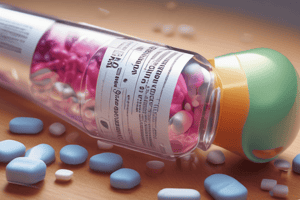Podcast
Questions and Answers
What class does Diphenhydramine (Benadryl) belong to?
What class does Diphenhydramine (Benadryl) belong to?
- Antihistamine (correct)
- Analgesic
- Antipyretic
- Anticholinergic (correct)
What is the mechanism of action of Diphenhydramine?
What is the mechanism of action of Diphenhydramine?
Blocks cellular histamine receptors, decreases vasodilation, decreases motion sickness, reverses extrapyramidal reactions.
What are the indications for using Diphenhydramine?
What are the indications for using Diphenhydramine?
Symptomatic relief of allergies, allergic reactions, anaphylaxis, acute dystonic reactions.
What are the contraindications for using Diphenhydramine?
What are the contraindications for using Diphenhydramine?
What are some adverse reactions associated with Diphenhydramine?
What are some adverse reactions associated with Diphenhydramine?
What drug interactions are important to consider with Diphenhydramine?
What drug interactions are important to consider with Diphenhydramine?
The adult dose of Diphenhydramine is _____ mg IV, IO, IM, or PO.
The adult dose of Diphenhydramine is _____ mg IV, IO, IM, or PO.
The pediatric dose of Diphenhydramine is _____ mg/kg IV, IO, IM, or PO.
The pediatric dose of Diphenhydramine is _____ mg/kg IV, IO, IM, or PO.
What is the duration of action for Diphenhydramine?
What is the duration of action for Diphenhydramine?
What special considerations should be noted when using Diphenhydramine in anaphylaxis?
What special considerations should be noted when using Diphenhydramine in anaphylaxis?
Study Notes
Diphenhydramine (Benadryl) Overview
- Classifies as an antihistamine and anticholinergic that helps combat allergic reactions.
Mechanism of Action
- Blocks histamine receptors at the cellular level, effectively decreasing vasodilation and alleviating motion sickness.
- Has the capability to reverse extrapyramidal reactions.
Indications
- Provides symptomatic relief for allergies, allergic reactions, anaphylaxis, and acute dystonic reactions.
Contraindications
- Not recommended for individuals with asthma, glaucoma, pregnancy, hypertension, infants, or those taking MAOIs.
Adverse Reactions
- Common adverse effects include sedation, hypotension, seizures, visual disturbances, urinary retention, palpitations, arrhythmias, and dry mouth.
- Can cause paradoxical CNS excitation, particularly in children.
Drug Interactions
- Alcohol and other anticholinergic substances may experience heightened effects when taken with diphenhydramine.
- Potential inhibition of corticosteroid activity; MAOIs can prolong the anticholinergic effects.
Dose and Administration
- Recommended adult dosage ranges from 25-50 mg via IV, IO, IM, or PO.
- For pediatric patients, the dosage is 1-2 mg/kg, also via IV, IO, IM, or PO.
Duration of Action
- Onset occurs within 15-30 minutes, reaching peak effect in 1 hour.
- Effects can last between 3 to 12 hours.
Special Considerations
- In cases of anaphylaxis, diphenhydramine should be administered alongside epinephrine and corticosteroids for optimal effect.
Studying That Suits You
Use AI to generate personalized quizzes and flashcards to suit your learning preferences.
Description
Test your knowledge on Diphenhydramine (Benadryl) with these flashcards covering essential terms, mechanisms of action, indications, and contraindications. Perfect for students learning about antihistamines and pharmacology.




